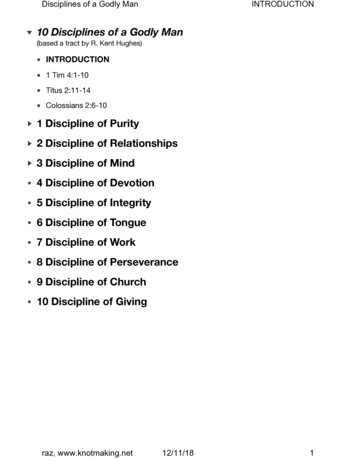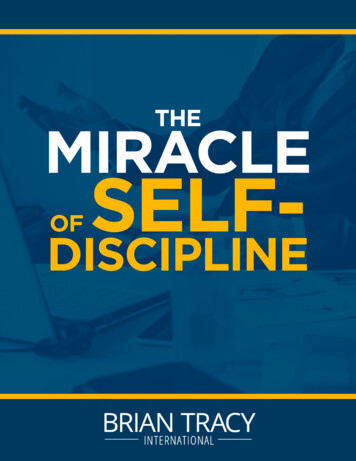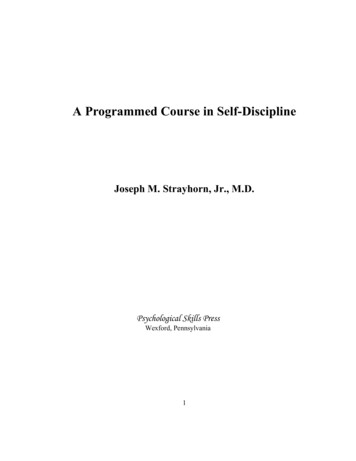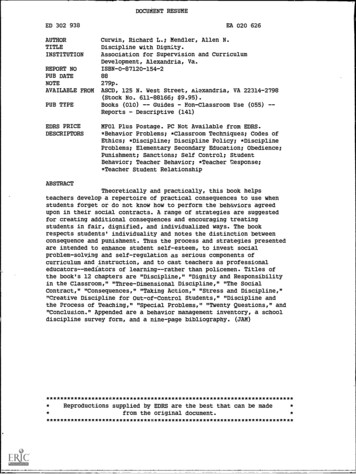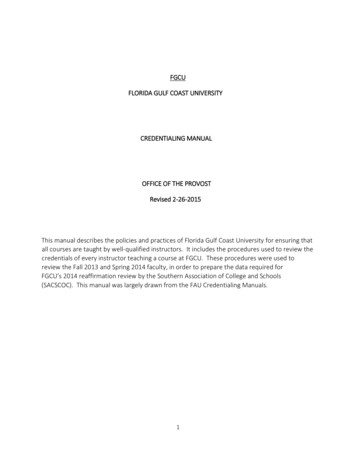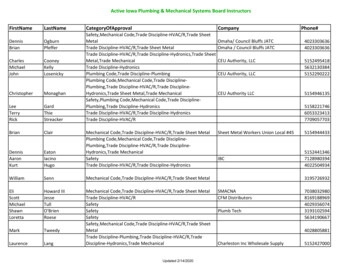
Transcription
International Academic Journal of Human Resource and Business Administration Volume 2, Issue 3, pp. 1-18EFFECTS OF DISCIPLINE MANAGEMENT ONEMPLOYEE PERFORMANCE IN AN ORGANIZATION:THE CASE OF COUNTY EDUCATION OFFICE HUMANRESOURCE DEPARTMENT, TURKANA COUNTYApalia Ekakoron AnthonyMaster of Business Administration in Strategic Managment, Mount Kenya University,Kenya 2017International Academic Journal of Human Resource and Business Administration (IAJHRBA) ISSN 2518-2374Received: 28th February 2017Accepted: 6th March 2017Full Length ResearchAvailable Online at: http://www.iajournals.org/articles/iajhrba v2 i3 1 18.pdfCitation: Apalia, E. A. (2017). Effects of discipline management on employeeperformance in an organization: The case of county education office human resourcedepartment, Turkana County. International Academic Journal of Human Resource andBusiness Administration, 2 (3), 1-18International Academic Journalswww.iajournals.org Open Access Peer Review Online Journal Publishers1 Page
International Academic Journal of Human Resource and Business Administration Volume 2, Issue 3, pp. 1-18ABSTRACTThe purpose of the study was toinvestigate the effects of disciplinarymanagement on employee performance inCounty Education Office of TurkanaCounty. Specifically the study aimed; todetermine the effects of code of disciplineon performance, to determine the effects ofdisciplinary procedures on performance, todetermine the effects of discipline systemson performance and to assess the effects ofdisciplinary actions on performance. Thestudy was conducted using a case studydesign. The target population for this studywas employees from the county educationoffice in Lodwar which composed a totalpopulation of 171 employees. The studysample comprised 1 (one) DistrictEducation Officer, 4 (four) departmentalmanagers and 166 (one hundred andsixteen) employees in the education officereflecting the ratio in the county officeaccessible sample staff size. The studyemployed purposive, stratified and simplerandom sampling techniques. Primarydata was collected with the help of aquestionnaire. Quantitative and qualitativedata analytical techniques were used.Quantitative data from questionnaires werecoded and summarized using ncy distributions and percentages.They thereafter analyzed using StatisticalPackage for Social Sciences (SPSS)version 20.Data was tested for significanceusing regression. Test for significance wasdone using the Pearson product-moment ofcorrelation coefficient. The study foundout that, respondents agreed that there wasincrease on employees’ knowledge;respondents agreed that disciplinarymanagement led to promotion ofemployees. The study also found out that,majority of the respondents ratedemployee performance, remuneration first,work environment and managementcommitment as first factors that that affectemployee performance also majority ratedmotivation, tools, equipment and otherresources second. The study alsoconcludes that the effective disciplinarypolicy County Education Office HumanResource Department in Turkana Countyare effective in that the organization hashelped in controlling employee’s behaviorby ensuring there is teamwork andcohesion in the organization. The studyalsorecommendsthatalthoughdisciplinary policy are important inbringing sanity to the organisation, thegovernment should seek to address thepertinent issues like complex disciplinaryregime that has impeded employeeperformance in the country. Humanresource management could utilise therecommended guidelines for moreeffective application of discipline inorganisations.Key Words: discipline management,employee performance, county educationoffice human resource department,Turkana CountyINTRODUCTIONOver the years, organizations have developed different mechanisms for providing employeeswith a formal opportunity to improve unacceptable performance. The first structuredintroduction of discipline into organizations was established in the United States of AmericaInternational Academic Journalswww.iajournals.org Open Access Peer Review Online Journal Publishers2 Page
International Academic Journal of Human Resource and Business Administration Volume 2, Issue 3, pp. 1-18in the 1930s in response to the trade unions’ request eliminating summary terminations. It’sin this place a progressive system of punishment was developed. It was envisaged that thisprocess would provide a worker with protection against job loss (Huberman, 2009). Theconcept of discipline in organizational context has been defined effectively by Kazdin's as,Punishment is the presentation of an aversive event or the removal of a positive eventfollowing a response which decreases the frequency of that response" [1975, pp. 33-34]. Arelationship or contingency exists between a response and the aversive consequences orstimuli (Bandura, 1973). In simple terms, the measure is the product that is used when certainbehaviors are observed. The product is meant to be unpleasant to discourage recurrence.In Africa, there are very rare circumstances where an employee will agree to a disciplinarysanction where the employer’s reasons are considered acceptable by the employee. In thesesituations, an employer is well advised to have the employee provide written confirmation ofthe acceptance of the action so that it will not later be used against the employer if theemployee thereafter is terminated or changes his mind as to the appropriateness of thedisciplinary action taken against him or her. Without the employee’s consent or a properlydocumented performance deficiency trail, an employer can still discipline employees as itconsiders appropriate by providing appropriate notice of the action (Banda, 2004).In Kenya especially, there are certain instances when an employee does not adhere to thenorms, rules and workplace ethics of the firm for which he/she works. However, no employeeis expected to be so unaware as to show serious issues of misconduct that are stretched over along period of time, causing loss to the company. This is where the role of human resourcemanagement is crucial, as someone needs to warn the employee before he creates a problemfor his teammates and colleagues. A warning letter specifies the exact cause of warning and isindirectly a signal for the employee, that if he/she does not amend his/her ways, the companywill be compelled to terminate his/her employment (Bewley, 2005).Locally where there are organizations where a number of people work together, it is quitelikely that company rules get broken intentionally or unintentionally. A single instance ofviolation, under genuine and well-justified circumstances might be forgiven. Repeatedinstances of violation might compel the company management to take strict action against anemployee in the form of suspension, termination of job and penalty. Organizations mightdirectly take such firm action, or issue a warning letter to the employee to give the employeea second chance (Handy, 1976).STATEMENT OF THE PROBLEMFor decades, organizations have used a fairly standardized procedure to handle familiarpersonnel problems such as absenteeism, poor performance, and other misconduct. Thisapproach, usually called "progressive discipline," provides for an increasingly serious seriesof penalties - reprimands, warnings, suspensions without pay - when employees fall out ofInternational Academic Journalswww.iajournals.org Open Access Peer Review Online Journal Publishers3 Page
International Academic Journal of Human Resource and Business Administration Volume 2, Issue 3, pp. 1-18step with the organization's expectations. When problems arise, the job of the manager is tofind the punishment that fits the crime.But today, a growing number of companies are moving away from using a criminal-justicementality for employee performance improvement through corrective action. They areabandoning traditional approaches that focus exclusively on punishment. Instead, they areadopting an approach of accountability - employees with unfavourable performance, conductor attendance issues are required to take personal responsibility for their choice of behaviour.Despite all these changes organizations in the County are still glued on traditional outdatedapproaches of discipline management and it’s in this light that the research seeks to dig outthe relationship that exist between discipline management and employee performance withspecific reference with the County Education officePURPOSE OF THE STUDYThe purpose of the study was to investigate the effects of disciplinary management onemployee performance in County Education Office of Turkana County.OBJECTIVES OF THE STUDY1.2.3.4.To determine the effects of code of discipline on performanceTo determine the effects of disciplinary procedures on performanceTo determine the effects of discipline systems on performanceTo assess the effects of disciplinary actions on performanceEMPIRICAL REVIEWEffects of code of discipline on performanceTo maintain harmonious relations and promote industrial peace, a Code of Discipline hasbeen laid down which applies to both public and private sector enterprises. It specifiesvarious obligations for the management and the workers with the objective of promotingcooperation between their representatives. According to Mafabi (1993), management is theprocess of working with and through people to accomplish organizational goals. Managementdeals with the establishment of rules and regulations as well as planning activities that aim atfulfilling the objectives of a particular organization. Rules are suggested or self-imposedguides for a scientific communication for conduct or action or an accepted procedure andcustom. Rules or standards of behavior can be defined as the shared expectations of a groupof people. These include what the group regards as a socially acceptable pattern of behaviorexpected of every individual in the group (Banda, 2004). Ideally, Organizations set rules andregulations for the proper governing of the various lifestyles of employees containing the dosand don’ts (Okumbe, 1998). Regulations on the other hand are authoritative orders with acourse of law intended to promote order and efficiency in an organization. Mullins andPeacock (1991), also concurred with Okumbe (1998), and argued that effective organizationsInternational Academic Journalswww.iajournals.org Open Access Peer Review Online Journal Publishers4 Page
International Academic Journal of Human Resource and Business Administration Volume 2, Issue 3, pp. 1-18demonstrate sound inclusive practices, which includes emphasizing rules and regulations,collaborative leadership and their good practice. The Organization rules and regulationstherefore prescribe the standard of behavior expected of the all employes. However theseresearchers did not say anything on the effect of organization rules and regulations onemployees’ performance and thus a need for this study.According to Adams (2003), Organization rules and regulation are among the strategiesdesigned to instill good conduct of employess just like students in a school. This implies self-control, orderliness, good behavior and obedience to organization authority (Adams, 2003).Also on employment, employees are given prospectuses, which spell out some of theexpectations (Adams, 2003). These rules and regulations specify in most cases what new staffshould do and what they should not do. Despite this expectation, in most cases in TurkanaCounty, staff break these rules and regulations with wide spread indiscipline acts such asabsenters from work without permission, taking of alcoholic drinks, and participating infrequent strikes these among others affect employees performance.Kabandize (2004) carried out a study on employees control through rules and regulations setby individual organizations in Uganda and observed that, rules and regulations are enforcedthrough management, disciplinary committees, supervisors and every one involvement in theprocess. According to Matsoga (2003), during his study on discipline in Organizations ofBotswana, he discovered the wide spread violence and misbehavior that existed in manyorganizations. This lack of discipline, which interfered with the normal organization workingprocess, manifested itself in various ways including absenteeism, vandalism, alcoholconsumption and substance abuse, truancy, inability or unwillingness to do delegated workby the supervisor. Theft was also identified as a common activity among staffs. Howeverthese researchers concentrated on discipline in organizations without studying its effects onemployees’ performance, which called for this study.The question is how the management of organizational rules does and regulations bymanagement affect employees performance? A critical analysis of the above studies did notprovide a clear answer. Much as the researchers had studied the way organizations rules andregulations control the employees’ behavior in organizations, a gap remained undiscoveredon how the administration of rules and regulations affect employee’s performance. This studywill therefore investigate the existing relationship between the administration of organizationrules and regulations by management and employees performance.Effects of disciplinary procedures and systems on performanceDiscipline should be imposed without generating resentment. McGregor propounded the “redhot stove rule” which says that a sound and effective disciplinary system in an organizationshould be immediate, consistent, impersonal, prior warning and notice acquaintance orknowledge of rules-timely action-fair and just action, positive approach.International Academic Journalswww.iajournals.org Open Access Peer Review Online Journal Publishers5 Page
International Academic Journal of Human Resource and Business Administration Volume 2, Issue 3, pp. 1-18Top management need to establish the service quality policy and charter that ensures thatservice quality objectives and complaints handling objectives are established, conductmanagement reviews, and ensure the availability of resources (Pheng & Jasmine, 2004).According to Ruzevicus (2005), top management is required to review the organization’smanagement systems for service quality, charter and complaints handling at planned intervalsto ensure their continuing suitability, adequacy, efficiency and effectiveness. This reviewshall include assessing opportunities for improvement and the need for changes, including theservice quality policy and objectives (Grönroos, 2000).The input to management review includes information on a follow-up actions from previousreviews, results of audit, customer feedback including results of customer satisfactionsurveys, changing customer requirements, feedback from other stakeholders, extent towhich objectives are achieved, status of preventive/corrective actions, review of processesperformance, and recommendations for improvement.Quality leadership by top management has been emphasized and supported by manyresearchers as the basis for proper quality management in order to achieve customersatisfaction, quality product, continuous improvement and job satisfaction (Cascio, 1998).Many organizations have fail because of the reluctance of top management in delegatingsome authorities and empower employees (Gomez-Mejia, 2010). This is a very crucial aspectbecause if the managers are committed in empowering the employees, the employees will beresponsible for the quality of their work and this will go a long way to enhance continuousimprovement. Top management should demonstrate empowerment by allowing its managersto take full responsibility and make decisions (Pheng & Jasmine, 2004).Organizations need to attract new employees who will contribute to the organization throughtheir abilities and values (Armstrong, 2006). Organizations require the service providers tohave two complementary capacities: service competencies and service inclination.Parasuraman, Zeithaml and Berry (1985) state that service competencies are the skills andknowledge necessary to do the job. In many cases, job applicants validate competencies, suchas attaining the particular degrees and relevant professional qualifications (Parasuraman etal., 1985).Disciplinary ActionsWhile disciplining an employee, it is always important to make sure that the disciplinaryaction meted out to the offender is always commensurate to the offence committed. Likeearlier said too, it is important to mete out the same punishment to the same category ofoffenders. Another important thing in punishing offenders is that the person must be giventhe opportunity to be heard. He must explain reasons for his action before a decision is takenagainst him. Certain mild offences should also be punished with mild penalties; According toTreasury board of Canada Secretariat guidelines on Discipline (2011) outlined someInternational Academic Journalswww.iajournals.org Open Access Peer Review Online Journal Publishers6 Page
International Academic Journal of Human Resource and Business Administration Volume 2, Issue 3, pp. 1-18measures; oral warning; written warning: loss of entitlement: suspension: demotion:termination of appointment and dismissalEffects of disciplinary actions on employees’ performanceBoth sides of the consequences on the application of discipline are reported by Atwater,Waldman, Carey and Cartier (2001) in their qualitative study: Recipient and observerreactions to discipline: are managers experiencing wishful thinking. Even though scholarlyevidence indicates that discipline and punishment are unfortunate facts of organizational fewconclusions have been drawn about the effects of punishment, or the relationship betweenpunishment and outcomes (Jac & Davidson, 2001). Atwater et al build on a study byBahemuka (1998). The Bahemuka study that was based on managerial perspective onpunishment. In the presented results the authors indicate that both recipients and observersbelieved that punishment can have positive outcomes.The negative effects of the application of discipline and or punishment were reported byChelliah (2010). He presents his findings in: Power Sharing in Progressive Discipline: NewRules of Engagement Arising from an Australian Perspective. He views progressivediscipline as a form of managerial power, which ultimately results in domination of theworker. Chelliah found that the application of progressive discipline on employees isparticularly concentrated around industry and occupational class workers. These workers aremore susceptible to disciplining by employers. Chelliah argues that an unequal power balanceexists between employee and employer in the progressive discipline system becauseprogressive discipline follows the traditional ‘power over’ model. Chelliah however does notcompletely discard the use of disciplinary measures.Up to now the review was concentrated on the effects of the application of disciplinarymeasures on the shoulders on the worker. Vard (2001) however took a different approach.He examined the relationship between perceived organizational climate and misbehavior atwork in an Israeli Metal Production Plant. The findings were publicized in:The Effects ofOrganizational and Ethical Climates on Misconduct at Work. The author builds on researchby Bateman and Zeithaml (1990) who states two major types of antecedents of misbehaviorat work: Individual factors (e.g., dissatisfaction, personality, moral development) andorganizational factors(e.g., goals, climate and control systems)Vard concurs with others researchers that individual behavior is strongly influenced by theorganization’s value system. The author found that a significant negative relationshipbetween Organizational Climate and behavior and between the Organizational Climatedimensions (Warmth and Support, and Reward), and misbehavior. His investigation supportsthe theoretical supposition that climate has both a positive and a negative effect on thebehavior of the workforce.International Academic Journalswww.iajournals.org Open Access Peer Review Online Journal Publishers7 Page
International Academic Journal of Human Resource and Business Administration Volume 2, Issue 3, pp. 1-18After a keen scrutiny of discipline definition by other researchers the author conquers withthem and gives its own definition of discipline as a systematic way of conducting thebusiness by the organizational members who strictly adhere to the essential rules andregulations. These employees/organizational members work together as a team so as toachieve organizational mission as well as vision and they truly understand that the individualand group aims and desires must be matched so as to ensure organizational success.Employees PerformanceAn organization consists of people who perform actions that should be in sync with thestrategic goals of the organization. In theory, if the people within the organization areperforming optimally based on the organizational goals, the organization should be asuccessful one. In theory and in practice, it is essential that employee performance beoptimized to ensure organizational success. Research findings have established that improvedworkplace performance and business results, if they occur, are caused not just by training, butalso by a myriad of other organizational influences, which are beyond the control of trainers:for example line manager behavior, remuneration and incentive systems, hiring practices,work environment, tools and equipment and a host of other aspects of the culture thatinfluence workplace performance and business results (Monappa, 2008).Improved performance requires the effective management of continuous developmentaddressing the core competencies of the organization and the capabilities of individuals andteams (Monappa, 2008). Besides, management can set performance dimensions when hiringan employee, during his/ her performance review, during strategic planning or at the start of anew project (Bruce & Pepitone, 1999). It is crucial that employees know what is expected ofthem, their role as part of the group and the organization, what is considered unacceptableperformance and what they have to do to reach the management’s standard of performance(Rothwell, 1999).Contemporary trends in human resource management show that within thedimension of skills and abilities, there are several criteria which may be applied depending onthe nature of work assignments (Mathis & Jackson, 1994).THEORETICAL FRAMEWORKThis theory will be profound from McGregor (1960) who developed a philosophical view ofhumankind with his. Theory X and Theory Y These are two opposing perceptions about howpeople view human behaviour at work and organisational life. Theory X states that; Peoplehave an inherent dislike for work and will avoid it whenever possible, People must becoerced, controlled, directed, or threatened with punishment in order to get them to achievethe organisational objectives, People prefer to be directed, do not want responsibility, andhave little or no ambition and People seek security above all else. With Theory Xassumptions, management’s role is to coerce and control employees.On the other hand Theory Y states; Work is as natural as play and rest, People will exerciseself-direction if they are committed to the objectives, Commitment to objectives is a functionInternational Academic Journalswww.iajournals.org Open Access Peer Review Online Journal Publishers8 Page
International Academic Journal of Human Resource and Business Administration Volume 2, Issue 3, pp. 1-18of the rewards associated with their achievement, People learn to accept and seekresponsibility, Creativity, ingenuity, and imagination are widely distributed among thepopulation. People are capable of using these abilities to solve an organisational problem andPeople have potential. With Theory Y assumptions, management’s role is to develop thepotential in employees and help them to release that potential towards common goals.This theoretical framework relates the disciplinee measures with employees’ performance. Itfurther suggests that there are critical linkages through a number of intermediate factors.Discipline should be imposed without generating resentment to develop employees toperform in an organization. An organization which manages disciplinee well and treats theiremployees as customers can achieve higher employee’s performance. Enhancing employees’performance can retain good employees and improve organization’s performance throughtaking full use of disciplinary strategies. Ultimately, the organization can achieveperformance through their employees. This study will engage the theory of McGregor, thuswill apply humanistic approach. This is because the approaches take into consideration theorganizations dimension of performance. There have been several approaches applied inanalyzing discipline. Among the various approaches are trickle down to humanistic approach.The study seeks how the discipline of employees through theory X where management’s roleis to coerce and control employees. And theory Y where management’s role is to develop thepotential in employees and help them to release that potential towards common goals theyrelate and impact on employee’s performance given application of any theory at anyparticular time.RESEARCH METHODOLOGYThe study was conducted using a case study design. This design aimed to collect data withoutmanipulating the research variables or the respondents in an attempt to get the perception ofthe respondents. The target population for this study was employees from the countyeducation office in Lodwar which composed a total population of 171 employees.The accessible samples for this study were employees of the county education office inLodwar. The study sample comprised 1 (one) District Education Officer, 4 (four)departmental managers and 166 (one hundred and sixteen) employees in the education officereflecting the ratio in the county office accessible sample staff size. Mugenda and Abel,(1999) suggest that for descriptive studies of the accessible population was enough sample.The study employed purposive, stratified and simple random sampling techniques. First theresearcher used the purposive technique to identify the District Education Officer and thedepartmental managers of the county education office in Lodwar. The population studied wasthen sub divided into stratums to get a more homogenous sub population. ThereafterStratified sampling technique and simple random sampling was used to select the employeesof the county education office in Lodwar. This method was used in order to avoid biasnessInternational Academic Journalswww.iajournals.org Open Access Peer Review Online Journal Publishers9 Page
International Academic Journal of Human Resource and Business Administration Volume 2, Issue 3, pp. 1-18whereby every member in the study category had an equal chance of participating in thestudy.In this study the primary data was collected with the help of a questionnaire, which wasadministered to the target population in the county education office in Lodwar. Thequestionnaires were in line with the study objectives, and contained both open and closedended questions.The questionnaire was administered to sampled respondents either throughself or researcher administered methods. In the self-administered method, questionnaireswere hand-delivered to respondents who were requested to complete the questionnairesthemselves and sent them back to the researcher. For the respondents who indicated that theywere committed or who had other assignments, the researcher used the questionnaire tointerview the respondents.Quantitative and qualitative data analytical techniques were used. Quantitative data fromquestionnaires were coded and summarized using descriptive statistics, measures ofvariability, frequency distributions and percentages. They thereafter analyzed using StatisticalPackage for Social Sciences (SPSS) version 20.Qualitative data was analyzed in themes and categories identifying patterns and trends thatwill emerge. The analysis included presentation of quotes from different respondents andrecording verbatim from what some respondents say. Themes emerging from secondary datawere identified and secondary data augmented the primary data. Data was tested forsignificance using regression formula:r n xy- x y n x2-( x)2 n y2-( y)2Where X was independent variables-discipline management variables this was sub divideaccording to the objectives of the research to X1- Availability of the documents X2Performance appraisal X3-Review of systems and X4-Number of Dismissal and Y wasdependent variable-customer satisfaction e.g time to serve customers. Test for significancewas done using the Pearson product-moment of correlation coefficient ast rSqrt[(1-r2)/(N-2)]To enhance validity a pilot study was carried out. The pilot study helped the researcher toidentify items in the research instrument which may be found to be ambiguous in elicitingrequired information. Reliability refers to the consistence of the research instruments. For thequestionnaire, the researcher carried out a Test-Retest method where a respondent whocompleted the questionnaire were asked to complete it again after two weeks and his/herchoices compared for consistence. According to Amin (2005), test-retest or stability testprovides evidence that scores obtained on a test at one time (test) are the same or close to thesame when the test is re-administered some other time (re-test).International Academic Journalswww.iajournals.org Open Access Peer Review Online Journal Publishers10 Page
International Academic Journal of Human Resource and Business Administration Volume 2, Issue 3, pp. 1-18RESEARCH RESULTSThe study found out that, res
employee in the form of suspension, termination of job and penalty. Organizations might directly take such firm action, or issue a warning letter to the employee to give the employee . employee performance in County Education Office of Turkana County. OBJECTIVES OF THE STUDY 1. To determine the effects of code of discipline on performance 2 .
